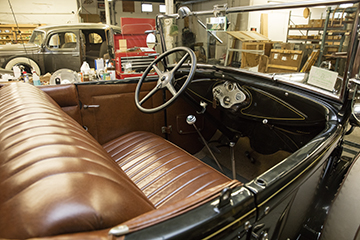Mary Godin is someone you want to know. Not for the benefits that come with knowing the chef at that chic waterfront restaurant. And not because the 82-year-old can score VIP tickets to the next brew festival (although, maybe).
No, Godin works at LeBaron Bonney Company, an antique and classic car upholstery factory in Amesbury. And she knows her rides.
“I’ve worked 44 years making old cars look new again,” says Godin. Her official title?
“Trouble,” she says.
Actually, it’s Cutter. Since 1972, Godin has been hand-cutting fabric interiors for collectors’ prized automobiles—everything from Henry Ford originals to gangster-era Buicks and classic 1960s Chevys. Most octogenarians can’t claim her expertise, but then most grandmas don’t work for LeBaron Bonney.
Lee Atherton and his brother Jack opened LeBaron Bonney on Cape Cod in 1938. What started as a bicycle rental service became a direct mail business selling historic maps and model ships. After World War II, the brothers transitioned to fine upholstered furniture.
But in 1959, when Jack Atherton purchased a 1937 Ford Model A Roadster to restore with his son, there was no shop around to repair the worn-out interior. So he turned to his expert furniture upholsterers, who accepted the challenge. At car shows, collectors admired the craftsmanship so much that LeBaron Bonney switched gears, so to speak, for the last time.
Today, the company’s upholstery gurus operate out of Amesbury’s Biddle and Smart Co. building, a 29,000-square-foot facility that once made horse carriages and frames for the first automobiles. The factory now offers custom interiors— headliners, panels, seats, cushions, carpets, and tops—for more than 800 cars built between 1916 and 1962. With the more recent acquisition of Hampton Coach, ABC Auto Interiors, and EZ Boy Auto Interiors, the factory also services cars built from the 1970s to the 2000s.
Most of the custom-made interiors are sold as kits to be installed by company-approved experts across the U.S. and Canada. But each year, a few customers opt for an in-house installation at the Amesbury factory. A walk through the installation room would make any car lover swoon.
There’s a beige 1937 Buick Roadmaster, with suicide doors and wide white wall tires (think Dick Tracy and tommy guns). LeBaron Bonney completely restored the interior in original mohair.
Then there’s the low-riding 1965 Chevy Nova, a pea-green beast and a symbol of mid-century family life in America. The inside is getting a navy blue rehab with original patterns throughout.
The company’s showpiece, though, is the steel-bodied 1931 Ford Model A Roadster, a metallic black antique convertible that looks as good as the day Jack Atherton completed its restoration.
“Every now and again we’ll bring it to a local show,” says Scott Holbrook, LeBaron Bonney’s president and part owner. “It almost takes a degree to start the thing.”
Not many people can say they rode in a new Ford Model A, but Amesbury resident Jack Gagne has never forgotten it. It was 1937, and it was the start of a deep nostalgia for antique autos.
“I used to get a ride all the time in the rumble seat of my uncle’s Roadster, just before he went into the service and put it away,” says the 78-year-old.
Decades later, Gagne bought his own ’37 Roadster and restored it. When it came time to resurrect the interior, he turned to LeBaron Bonney.
“They’re known as the best in the country,” says Gagne, “and there aren’t that many upholstery makers around. You mention a LeBaron Bonney interior when you’re selling a car, and that always gets a great rating.”
Hollywood has also relied on the Amesbury shop. According to Holbrook, LeBaron Bonney sold door panels and fabric to the Back to the Future III set. And a customer’s 1929 Ford Model A Sport Coupe was used on the set of Tom Hanks’s Road to Perdition. During production, the car’s top was reportedly ruined and producers paid LeBaron Bonney for a replacement.
For most antiques from the 1920s and 1930s, a custom kit typically costs $1,500–$2,000. Leather and larger, late-model car interiors can cost $6,000–$12,000. Why would someone pay so much? Holbrook points to the time it takes to hand-cut and stitch the materials, and the value that a LeBaron Bonney interior adds. But it’s not just about craftsmanship and market value.
“For a lot of the customers, the car was in the family,” he says. “It’s ‘I remember working on it with my grandfather back in 1963.’ It’s very personal.”
It’s personal for the company’s employees and suppliers, too. Like Godin, many of LeBaron Bonney’s 30 workers have been with the factory for decades, and most of the materials are sourced in the U.S. A North Shore artisan still carves the solid oak seat frames, and Pennsylvania craftsmen still heat-bend the wooden bows used in the antique convertible tops.
Given the loss of American manufacturing, the shop’s commitment to tradition is as much a throwback as the cars it restores.
“I love all these old cars,” says Godin. “I go to shows, and the cars that I know should be mohair, they’re turning them into fancy hot rods. They’re nice-looking, but it bothers me. It’s not how it’s supposed to be.”
LeBaron Bonney Company
6 Chestnut Street, Amesbury
800-221-5408

